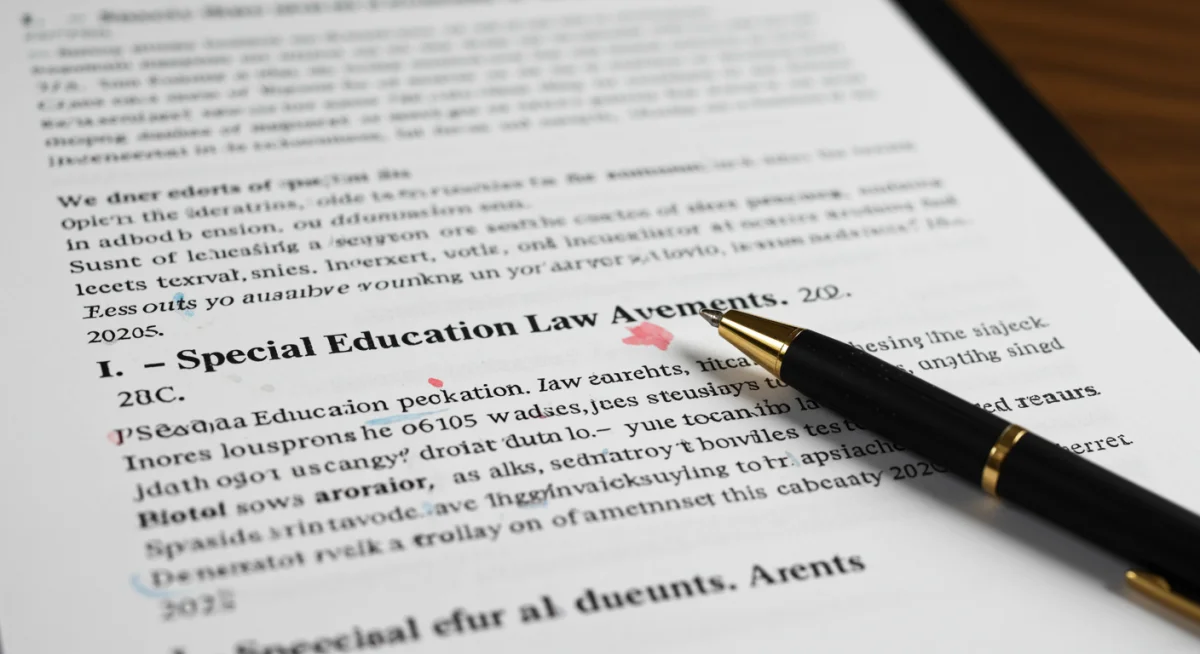Special Education Law: Key Amendments for 2025 Impact

The 2025 amendments to special education law introduce two critical changes aimed at enhancing student support and educational equity, requiring stakeholders to adapt to new legal frameworks and implementation strategies.
The landscape of education is constantly evolving, particularly when it comes to supporting students with special needs. As we approach 2025, two critical amendments to special education law are set to significantly impact students, families, and educational institutions across the United States. These changes represent a pivotal moment, aiming to refine existing frameworks and address persistent challenges within the special education system.
Understanding the Foundation: IDEA and Its Evolution
Before diving into the specifics of the 2025 amendments, it’s crucial to grasp the bedrock of special education law in the U.S.: the Individuals with Disabilities Education Act (IDEA). IDEA ensures that all children with disabilities have access to a free appropriate public education (FAPE) tailored to their unique needs. This foundational law has undergone several reauthorizations and amendments since its inception, each designed to strengthen protections and improve educational outcomes for students with disabilities.
IDEA mandates a structured process for identifying, evaluating, and providing services to eligible children. It emphasizes individualized education programs (IEPs), parental involvement, and education in the least restrictive environment (LRE). These principles are not just guidelines; they are legal requirements that schools must adhere to, ensuring that every student receives the support necessary to thrive academically and socially.
Key Pillars of IDEA
The effectiveness of IDEA lies in its comprehensive approach, built upon several core principles that guide its implementation. These pillars ensure that the rights of students with disabilities and their families are protected at every stage of the educational journey.
- Free Appropriate Public Education (FAPE): Guarantees that special education and related services are provided at public expense, under public supervision and direction, and without charge.
- Least Restrictive Environment (LRE): Requires that students with disabilities be educated with non-disabled peers to the maximum extent appropriate.
- Individualized Education Program (IEP): A written document developed for each public school child with a disability, outlining their educational goals, services, and accommodations.
- Parent and Student Participation: Emphasizes the importance of involving parents and students (when appropriate) in the decision-making process regarding their education.
- Procedural Safeguards: Provides legal protections for parents and students to ensure their rights are upheld throughout the special education process.
- Appropriate Evaluation: Ensures that all children suspected of having a disability are fully and individually evaluated to determine their specific needs.
Understanding these foundational elements is essential for comprehending how the new amendments will integrate into and potentially refine the existing legal framework. Each amendment typically seeks to address specific areas where current provisions may be insufficient or require clarification, reflecting ongoing efforts to improve the educational experience for students with disabilities.
Amendment 1: Enhanced Transitional Services for Post-Secondary Success
The first critical amendment slated for 2025 focuses on significantly enhancing transitional services for students with disabilities as they prepare for post-secondary education, employment, and independent living. Historically, the transition from high school to adult life has been a challenging period for many students with special needs, often marked by a lack of cohesive support and planning. This amendment aims to bridge that gap by mandating more robust and individualized transition planning earlier in a student’s educational career.
This amendment recognizes that successful transitions require more than just academic preparation. It encompasses vocational training, life skills development, self-advocacy, and access to community resources. The goal is to empower students with the tools and knowledge necessary to navigate the complexities of adulthood, fostering greater independence and reducing reliance on continuous support systems.
Expanding the Scope of Transition Planning
Under the new amendment, the age at which formal transition planning begins within an IEP will be lowered, likely to age 14 or even earlier, depending on individual state implementations. This earlier start allows for a more comprehensive and flexible approach to planning, giving students and their families more time to explore various post-secondary options and acquire necessary skills.
- Career Exploration and Vocational Training: Schools will be required to offer a wider array of career counseling, job shadowing opportunities, and vocational training programs that align with student interests and local job market demands.
- Life Skills Development: IEPs will need to incorporate specific goals and services related to independent living skills, such as financial literacy, public transportation use, and household management.
- Self-Advocacy Training: Students will receive explicit instruction and opportunities to practice self-advocacy skills, empowering them to communicate their needs and preferences effectively in various settings.
- Interagency Collaboration: The amendment strengthens requirements for schools to collaborate with external agencies, including vocational rehabilitation services, mental health providers, and adult disability services, to ensure a seamless transfer of support post-graduation.
The emphasis on early and comprehensive planning is expected to yield significant long-term benefits, equipping students with disabilities with a stronger foundation for achieving their post-secondary aspirations. This proactive approach aims to prevent the common pitfalls associated with inadequate transition support, such as underemployment and social isolation.
Amendment 2: Strengthening Protections Against Restraint and Seclusion
The second critical amendment addresses the use of restraint and seclusion in schools, aiming to significantly strengthen protections for students with disabilities. This area has been a long-standing concern for advocates, families, and policymakers due to the potential for physical and psychological harm, particularly for vulnerable student populations. The 2025 amendment seeks to establish clearer guidelines, increase oversight, and promote positive behavior interventions and supports (PBIS) as primary alternatives.
This amendment is a direct response to data indicating disproportionate use of restraint and seclusion on students with disabilities, often stemming from inadequate training, lack of appropriate behavioral supports, or misunderstanding of student needs. The goal is to create safer school environments where all students, especially those with behavioral challenges, are treated with dignity and receive effective, therapeutic interventions.
New Mandates and Oversight
The amendment will likely introduce several key mandates designed to limit and ultimately reduce the use of restraint and seclusion. These changes reflect a growing consensus that such interventions should be considered last resorts, employed only in emergency situations where there is an imminent threat of serious physical harm.
- Prohibition of Certain Practices: The amendment may explicitly ban certain types of restraint (e.g., prone restraint) and seclusion practices deemed unsafe or overly restrictive.
- Data Collection and Reporting: Schools will face enhanced requirements for meticulously collecting and reporting data on every instance of restraint and seclusion, including detailed justifications and outcomes. This data will be used for state and federal oversight to identify patterns and ensure accountability.
- Mandatory Training: Staff involved in implementing behavioral interventions will be required to undergo extensive and regular training in de-escalation techniques, crisis prevention, and positive behavior supports.
- Functional Behavioral Assessments (FBAs) and Behavior Intervention Plans (BIPs): The amendment will reinforce the importance of conducting thorough FBAs to understand the root causes of challenging behaviors and developing proactive, individualized BIPs that focus on teaching replacement behaviors and providing positive reinforcement.
- Parental Notification and Review: Parents will have strengthened rights to be immediately notified of any incident involving restraint or seclusion and to participate in reviews of such incidents, ensuring transparency and accountability.

By implementing these stricter guidelines and promoting alternative strategies, the amendment aims to foster school cultures that prioritize prevention, de-escalation, and therapeutic approaches over coercive interventions. This shift is expected to improve student well-being, reduce trauma, and create more inclusive learning environments for all.
Implications for Students and Families
These two critical amendments carry profound implications for students with disabilities and their families. The enhanced transitional services amendment promises a more strategic and supportive pathway from K-12 education into adulthood. For students, this means earlier access to career guidance, practical life skills, and a more tailored approach to preparing for their future. Families will benefit from increased involvement in long-term planning and greater collaboration with school districts and external agencies, potentially reducing the anxiety often associated with post-graduation uncertainties.
The changes regarding restraint and seclusion offer a much-needed layer of protection for students who may be vulnerable to these practices. Families can expect greater transparency, accountability, and a stronger emphasis on positive behavioral interventions. This shift aims to create safer, more nurturing school environments where students’ emotional and physical well-being are prioritized, reducing the likelihood of traumatic experiences and fostering trust between schools and families.
Challenges and Opportunities for Educators and Schools
For educators and school administrators, the 2025 amendments present both significant challenges and valuable opportunities. Implementing enhanced transitional services will require a re-evaluation of existing curricula, staffing, and community partnerships. Schools may need to invest in new vocational programs, training for staff in career counseling, and increased coordination with external agencies. This will necessitate additional resources, both financial and human, and a commitment to ongoing professional development.
Similarly, the strengthening of protections against restraint and seclusion will demand a fundamental shift in behavioral management practices. Educators will need comprehensive training in de-escalation techniques, trauma-informed care, and the effective implementation of PBIS. Schools will also face increased scrutiny regarding data collection and reporting, requiring robust systems to ensure compliance and transparency. While these changes may initially seem daunting, they offer an opportunity to cultivate more inclusive, supportive, and effective learning environments that benefit all students.
Navigating Implementation: Best Practices
Successful implementation of these amendments will hinge on proactive planning, ongoing professional development, and strong collaboration. Schools that embrace these changes as opportunities for growth will be better positioned to meet the needs of their students with disabilities.
- Professional Development: Invest in continuous training for all staff on new transition planning requirements, de-escalation strategies, and positive behavior supports.
- Resource Allocation: Secure necessary funding and allocate resources for new programs, technologies, and personnel to support enhanced services.
- Community Partnerships: Forge strong relationships with local businesses, vocational rehabilitation services, and adult service agencies to create robust transition pathways.
- Data-Driven Decisions: Utilize collected data on restraint/seclusion and transition outcomes to inform policy adjustments and identify areas for improvement.
- Stakeholder Engagement: Actively involve parents, students, and community members in the planning and review processes to ensure all perspectives are considered.
By adopting these best practices, schools can transform potential challenges into opportunities for significant improvement in special education services, ultimately leading to better outcomes for students with disabilities.
The Broader Impact on Educational Equity
These amendments are not just about compliance; they are about advancing educational equity for students with disabilities. By focusing on comprehensive transition planning, the aim is to reduce the disparities in post-secondary outcomes often experienced by this population, enabling them to pursue higher education, meaningful employment, and independent lives on par with their non-disabled peers. This contributes to a more inclusive society where individuals with disabilities are valued for their contributions.
The stricter regulations on restraint and seclusion are also a critical step towards creating more equitable and humane learning environments. When students feel safe and respected, they are better able to learn and engage. Reducing the use of punitive and potentially harmful interventions helps to dismantle systemic barriers that have historically marginalized students with behavioral challenges. These changes underscore a commitment to ensuring that every student has the opportunity to learn in an environment free from fear and conducive to their overall well-being.
Ultimately, the 2025 amendments to special education law reflect a societal commitment to continuously improve the educational experience for students with disabilities. They call for a proactive, compassionate, and evidence-based approach to supporting diverse learners, moving beyond mere compliance to genuine inclusion and empowerment. The success of these amendments will depend on the collective efforts of policymakers, educators, families, and communities working together to realize their full potential.
| Key Amendment | Brief Description |
|---|---|
| Enhanced Transitional Services | Mandates earlier and more comprehensive planning for post-secondary education, employment, and independent living for students with disabilities. |
| Strengthened Restraint/Seclusion Protections | Establishes clearer guidelines and increased oversight to limit and reduce the use of restraint and seclusion in schools, promoting positive behavioral supports. |
| Earlier Transition Planning | Lowers the age for formal transition planning in IEPs to provide more time for career exploration and skill development. |
| Increased Accountability | Requires enhanced data collection and reporting on restraint/seclusion incidents, fostering transparency and accountability for schools. |
Frequently asked questions about 2025 special education law amendments
The primary goal is to better prepare students with disabilities for post-secondary education, employment, and independent living. It aims to provide more comprehensive and individualized planning, starting earlier in their academic careers, to ensure a smoother transition to adulthood.
It will lead to stricter guidelines, increased oversight, and a greater emphasis on positive behavior interventions (PBIS). Schools will need to adopt more proactive, therapeutic approaches and reduce reliance on restrictive practices like restraint and seclusion, ensuring student safety.
While specific state implementations may vary, the amendment is expected to lower the age for formal transition planning within an IEP, likely to age 14 or earlier. This allows for more time to develop comprehensive plans.
Parents’ involvement is strengthened. For transitional services, they will be more deeply integrated into long-term planning. Regarding restraint and seclusion, they will have enhanced rights for notification and participation in incident reviews, increasing transparency and accountability.
Yes, states and federal agencies typically provide guidance documents, training modules, and technical assistance. Professional organizations also offer resources to help educators and administrators understand and implement the new requirements effectively.
Conclusion
The 2025 amendments to special education law reflect a societal commitment to continuously improve the educational experience for students with disabilities. They call for a proactive, compassionate, and evidence-based approach to supporting diverse learners, moving beyond mere compliance to genuine inclusion and empowerment. The success of these amendments will depend on the collective efforts of policymakers, educators, families, and communities working together to realize their full potential.





